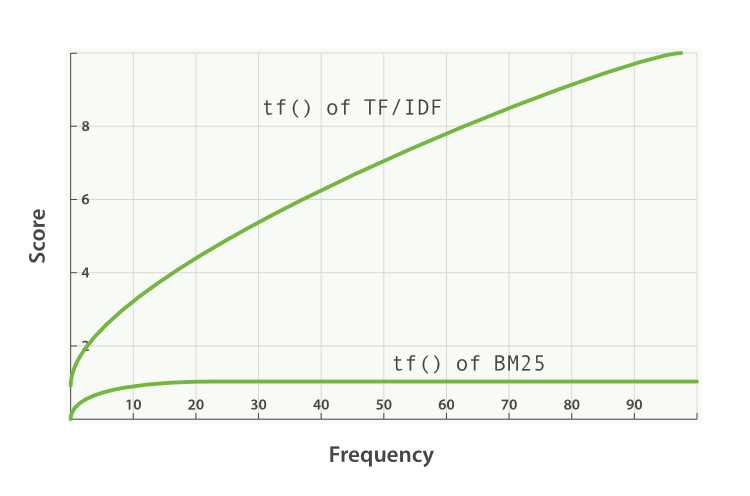ES BM25 TF-IDF相似度算法设置——
Before we move on from relevance and scoring, we will finish this chapter with a more advanced subject: pluggable similarity algorithms. While Elasticsearch uses the Lucene’s Practical Scoring Function as its default similarity algorithm, it supports other algorithms out of the box, which are listed in the Similarity Modules documentation.
Okapi BM25
The most interesting competitor to TF/IDF and the vector space model is called Okapi BM25, which is considered to be a state-of-the-art ranking function. BM25 originates from the probabilistic relevance model, rather than the vector space model, yet the algorithm has a lot in common with Lucene’s practical scoring function.
Both use term frequency, inverse document frequency, and field-length normalization, but the definition of each of these factors is a little different. Rather than explaining the BM25 formula in detail, we will focus on the practical advantages that BM25 offers.
Term-frequency saturation
Both TF/IDF and BM25 use inverse document frequency to distinguish between common (low value) words and uncommon (high value) words. Both also recognize (see Term frequency) that the more often a word appears in a document, the more likely is it that the document is relevant for that word.
However, common words occur commonly. The fact that a common word appears many times in one document is offset by the fact that the word appears many times in all documents.
However, TF/IDF was designed in an era when it was standard practice to remove the most common words (or stopwords, see Stopwords: Performance Versus Precision) from the index altogether. The algorithm didn’t need to worry about an upper limit for term frequency because the most frequent terms had already been removed.
In Elasticsearch, the standard analyzer—the default for string fields—doesn’t remove stopwords because, even though they are words of little value, they do still have some value. The result is that, for very long documents, the sheer number of occurrences of words like the and and can artificially boost their weight.
BM25, on the other hand, does have an upper limit. Terms that appear 5 to 10 times in a document have a significantly larger impact on relevance than terms that appear just once or twice. However, as can be seen in Figure 34, “Term frequency saturation for TF/IDF and BM25”, terms that appear 20 times in a document have almost the same impact as terms that appear a thousand times or more.
This is known as nonlinear term-frequency saturation.
Figure 34. Term frequency saturation for TF/IDF and BM25

Field-length normalization
In Field-length norm, we said that Lucene considers shorter fields to have more weight than longer fields: the frequency of a term in a field is offset by the length of the field. However, the practical scoring function treats all fields in the same way. It will treat all title fields (because they are short) as more important than all body fields (because they are long).
BM25 also considers shorter fields to have more weight than longer fields, but it considers each field separately by taking the average length of the field into account. It can distinguish between a shorttitle field and a long title field.
In Query-Time Boosting, we said that the title field has a natural boost over the bodyfield because of its length. This natural boost disappears with BM25 as differences in field length apply only within a single field.
ES BM25 TF-IDF相似度算法设置——的更多相关文章
- ES 相似度算法设置(续)
Tuning BM25 One of the nice features of BM25 is that, unlike TF/IDF, it has two parameters that allo ...
- 信息检索中的TF/IDF概念与算法的解释
https://blog.csdn.net/class_brick/article/details/79135909 概念 TF-IDF(term frequency–inverse document ...
- 基于TF/IDF的聚类算法原理
一.TF/IDF描述单个term与特定document的相关性TF(Term Frequency): 表示一个term与某个document的相关性. 公式为这个term在document中出 ...
- ES设置查询的相似度算法
similarity Elasticsearch allows you to configure a scoring algorithm or similarity per field. The si ...
- Elasticsearch由浅入深(十)搜索引擎:相关度评分 TF&IDF算法、doc value正排索引、解密query、fetch phrase原理、Bouncing Results问题、基于scoll技术滚动搜索大量数据
相关度评分 TF&IDF算法 Elasticsearch的相关度评分(relevance score)算法采用的是term frequency/inverse document frequen ...
- 25.TF&IDF算法以及向量空间模型算法
主要知识点: boolean model IF/IDF vector space model 一.boolean model 在es做各种搜索进行打分排序时,会先用boolean mo ...
- 55.TF/IDF算法
主要知识点: TF/IDF算法介绍 查看es计算_source的过程及各词条的分数 查看一个document是如何被匹配到的 一.算法介绍 relevance score算法,简单来说 ...
- tf–idf算法解释及其python代码实现(下)
tf–idf算法python代码实现 这是我写的一个tf-idf的简单实现的代码,我们知道tfidf=tf*idf,所以可以分别计算tf和idf值在相乘,首先我们创建一个简单的语料库,作为例子,只有四 ...
- tf–idf算法解释及其python代码实现(上)
tf–idf算法解释 tf–idf, 是term frequency–inverse document frequency的缩写,它通常用来衡量一个词对在一个语料库中对它所在的文档有多重要,常用在信息 ...
随机推荐
- Vue 响应式数据说明
值得注意的是只有当实例被创建时 data 中存在的属性才是响应式的.也就是说如果你添加一个新的属性,比如: vm.b = 'hi' 那么对 b 的改动将不会触发任何视图的更新. 这里唯一的例外是使用 ...
- Android BitmapFactory图片压缩处理(大位图二次採样压缩处理)
Android实际开发中.在载入大量图片的时候.比方ViewPager.GridView.ListView中,载入了大量的比較大图片就easy出现OOM(内存溢出)的异常,这是由于一个应用的最大内存使 ...
- 记录MySQL运行的SQL
对照Oracle功能去学习Mysql总会发现亮点 Oracle中通过日志挖掘这一技能,能够找到以前运行过的全部记录: Mysql中也提供了3种方法{验证过的,我会记录详细做法} 方法1:{已验证} 记 ...
- 我的IT之路
在写这篇文章的时候内心是无比激动,因为这辈子是注定和IT打交道了. 都说大学时光是美好的,但却只有到了大四才知道时间是短暂的,也许和许多人一样,我的大学主要时光是在游戏中度过,1000多把的寒冰算是同 ...
- HDU 2242 考研路茫茫——空调教室(边双连通)
HDU 2242 考研路茫茫--空调教室 题目链接 思路:求边双连通分量.然后进行缩点,点权为双连通分支的点权之和,缩点完变成一棵树,然后在树上dfs一遍就能得出答案 代码: #include < ...
- S:33184777
https://github.com/wjlWork/Crawl/tree/da0b63bc43bd7c238963f834a11df2581cecfb9c https://github.com/wh ...
- jdbc 链接池
package cn.itcast.jdbc.datasourse; import java.sql.Connection;import java.sql.DriverManager;import j ...
- linux查看磁盘挂载的三种方法
第一种方法:使用df命令,例如: orientalson:/home # df Filesystem 1K-blocks Used Available Use% Mounted on /dev/sda ...
- linux环境tomcat配置及hadoop 2.6伪分布模式安装配置
一.ubuntu 15.04.openjdk1.7.tomcat7环境配置 1. 配置openjdk1.7,输入命令: -jdk 2. 查看java是否安装成功,输入命令: envjava -vers ...
- OpenCV 中的三大数据类型:CvMat 类型
前言 本文将介绍 OpenCV 中的矩阵结构 CvMat 并提供几个很常用的矩阵使用方法. 更多的矩阵处理函数还请参阅相关资料. CvMat 的类型定义 typedef struct CvMat { ...
